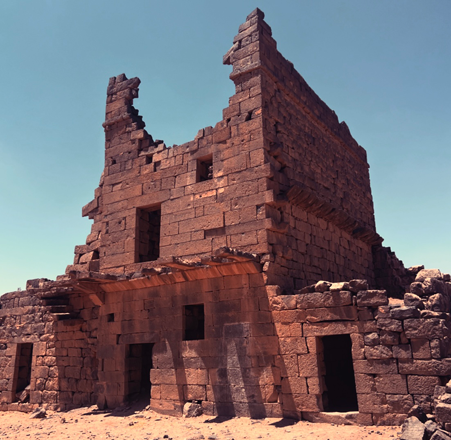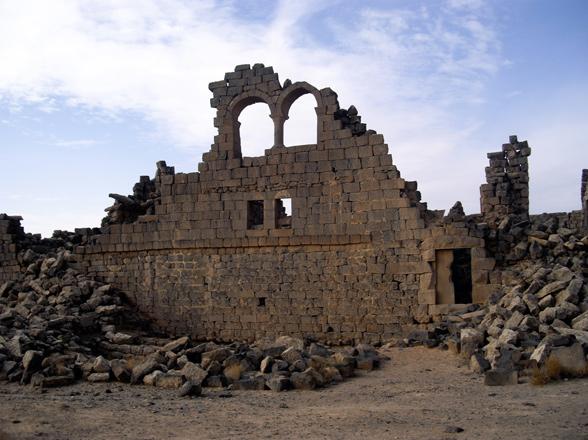You are here
The ‘black city’ of Um Al Jimal: at the crossroads of civilisations
By Saeb Rawashdeh - Feb 01,2017 - Last updated at Feb 02,2017

Located 70km northeast of Amman, Um Al Jimal was established by the Nabataeans and continued under the Romans, later being revived by thriving Byzantine and Umayyad communities (Photos courtesy of ummeljimal.org)
AMMAN — If Petra is the “rose-red” city, Um Al Jimal is a city of “all black”, constructed exclusively with dark, volcanic basalt rock.
Located 70km northeast of the capital, the site was established by the Nabataeans and continued under the Romans, later being revived by thriving Byzantine and Umayyad communities.
After destruction by an earthquake, it was sporadically inhabited until it was resettled by Druze and Masaeid in the 20th Century.
“Um Al Jimal was a frontier town on the edge of the badia, likely first inhabited by Nabataean traders caravanning between Petra and Damascus,” Bert de Vries, a scholar focusing on the site, told The Jordan Times in a recent interview.
“With the arrival of Rome in the second century AD, the village eventually became part of the Limes Arabicus — the line of garrisoned forts that protected the Roman province of Arabia,” he said.
De Vries spent decades excavating, preserving and interpreting the site as director of the Um Al Jimal Project.
Although he retired in 2013 as a history proffesor at Calvin College, he continues to run the Um Al Jimal Project with a team of local and foreign scholars.
Um Al Jimal’s black building material lent itself to typical frontier architecture, as basalt is durable and provides good insulation, cooling the summer heat and shielding from the winter cold, the professor noted.
According to de Vries, the black volcanic stone — today often mottled in appearance from lichen, dust, and age — was so sturdy that many homes were built to three storeys tall, with the tower of the so-called Barracks (or later castellum) six stories above the ground.
“The results lasted a long time: Not only were buildings maintained and reused over centuries of continuous occupation, but many were reoccupied in the early 20th century and over 150 are still at least partially standing today,” de Vries claimed.
The town had a population of several thousand and enjoyed relative autonomy during the Byzantine and early Islamic empires, after the Roman military’s hold on the region had diminished.
The site sits on the edge of a lava plain that stretches in all directions from Jabal Al Arab in Syria, said the scholar.
“This huge deposit was created by a series of eruptions from the mountain and various fissures on its slopes,” de Vries explained.
The moderate climate of Um Al Jimal encouraged its habitation, which “fluctuated over time between pastoral nomadism and agricultural sedentism”, he stressed.
This pattern was then interrupted by 800 years of continuous settlement, from the Nabataean to the Abbasid periods.
Religion played an important role in the history of Um Al Jimal, the expert argued, adding that it is often treated as a “central component of the sociopolitical construction of security in ancient societies”.
“At Um Al Jimal, such socio-religious experience could be especially rich because its location in the Houran puts it at a religious-cultural intersection, between Syria to the north and Arabia to the south, and between the Levantine coast to the west and the desert to the east,” de Vries said.
Between the 1st and 4th centuries AD, the local religion was polytheistic and of an “eclectic sort, typical of the post-Alexander era”, he underlined.
After Roman power declined, a small military structure, the Barracks, was commissioned by a Christian Duke, Pelagius, in AD 411-12, who flanked its dedicatory inscription with symbols of the cross.
By the end of the 6th century, Um Al Jimal had 16 churches and chapels, and around 150 houses.
“Some churches had simple plaster floors; others [had mosaics] in Madaba-school patterns, and one had simpler mosaics more typical of Umayyad-era flooring,” the expert emphasised.
The mosaics depicted animals, plants and geometric patterns.
“Because they are incredibly fragile, Um Al Jimal’s remaining mosaics are a prime concern for the site’s long-term conservation efforts,” he stressed.
The Islamic conquest drew Um Al Jimal into the political sphere of Mecca in the early 7th century and of Damascus later in the Umayyad period, but on the domestic side, there was apparent cultural continuity and gradual, rather than abrupt, change, de Vries explained.
“As was typical for the region, converts to Islam lived in harmony with the majority who most likely remained Christian,” he said.
The temporary Druze settlers (1910-1932) did plenty of remodelling in the Byzantine-Umayyad ruins, but after they left, these houses were reoccupied as dwellings and stables by members of the Masaeid tribe in the mid-20th century.
True to their nomadic heritage, the Masaeid also left numerous tent sites among the ruins before they built mud-brick and, later, cement houses in the village surrounding the ruins.
Since 1970, however, the Byzantine-Umayyad site has been managed as an archaeological reserve by the Department of Antiquities.
Beginning in 2009, the Um Al Jimal Project has partnered with the current generation of Masaeids and the Ministry of Tourism and Antiquities to preserve and present the archaeological site as a monument of Jordanian heritage to be enjoyed by international, Jordanian and local visitors.
While this work was enabled by a cohort of international funding agencies — Jordanian, Norwegian, German and US through the USAID Sustainable Cultural Heritage Through Engagement of Local Communities Project — it is dedicated to the engagement of the local Masaeid community in the long-term management of the site for their own benefit and enjoyment.
“We are currently developing an interpretive and hospitality centre, completing interpretive trails and reactivating the ancient surface runoff water collection system for redistribution to the modern residents,” de Vries concluded.
Related Articles
AMMAN — The United Nations Educational, Scientific and Cultural Organisation (UNESCO) has announced the inclusion of Umm Jimal to the UNESCO
AMMAN — The lack of coins at Um Al Jimal, located 70 km northeast of Amman, forced researchers to rely on ceramics as the primary tool used
Umm Al Jimal/Mafraq — Following the inscription of Umm Al Jimal on the UNESCO World Heritage List, Jordan is working on registering other si


















